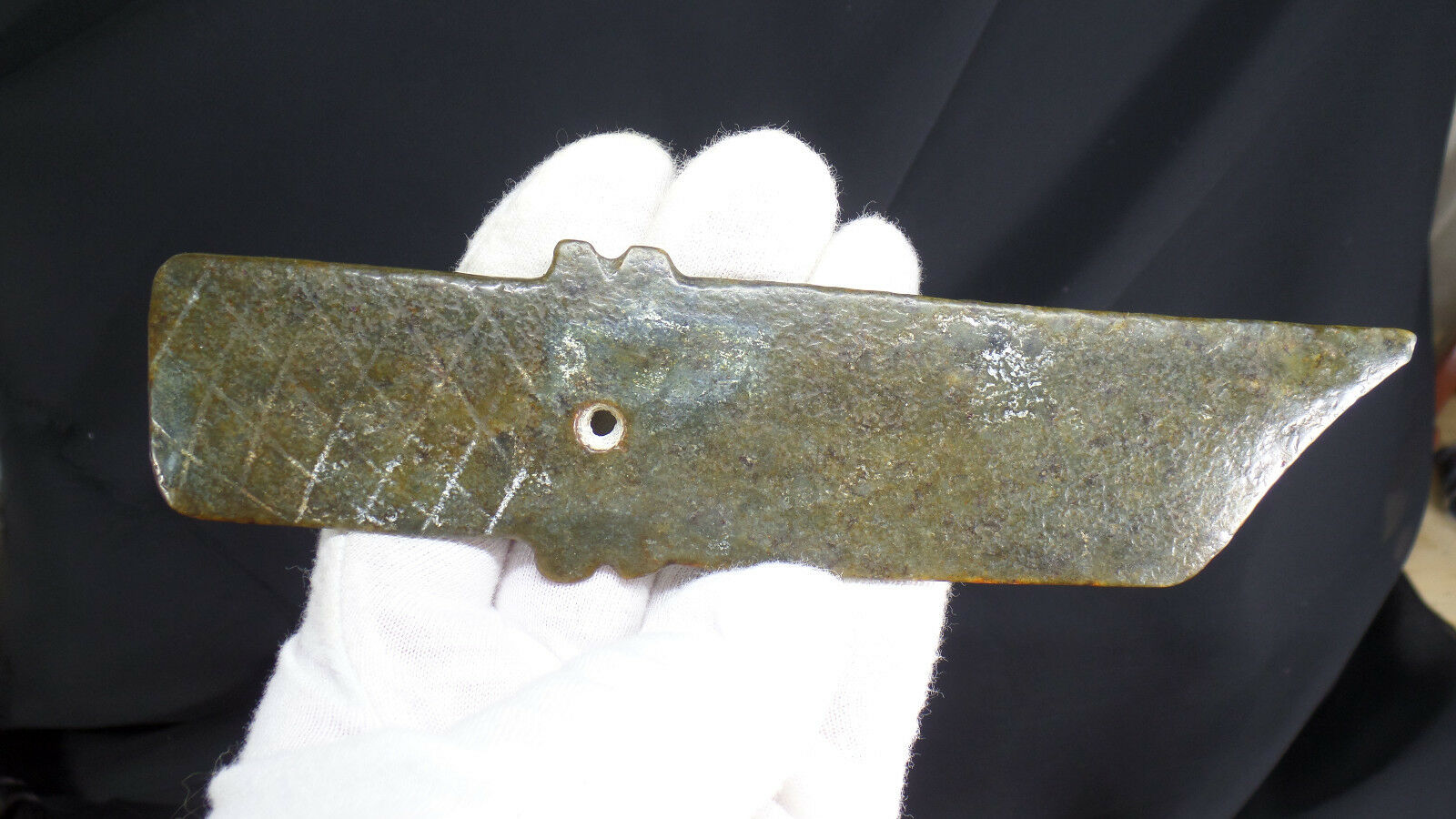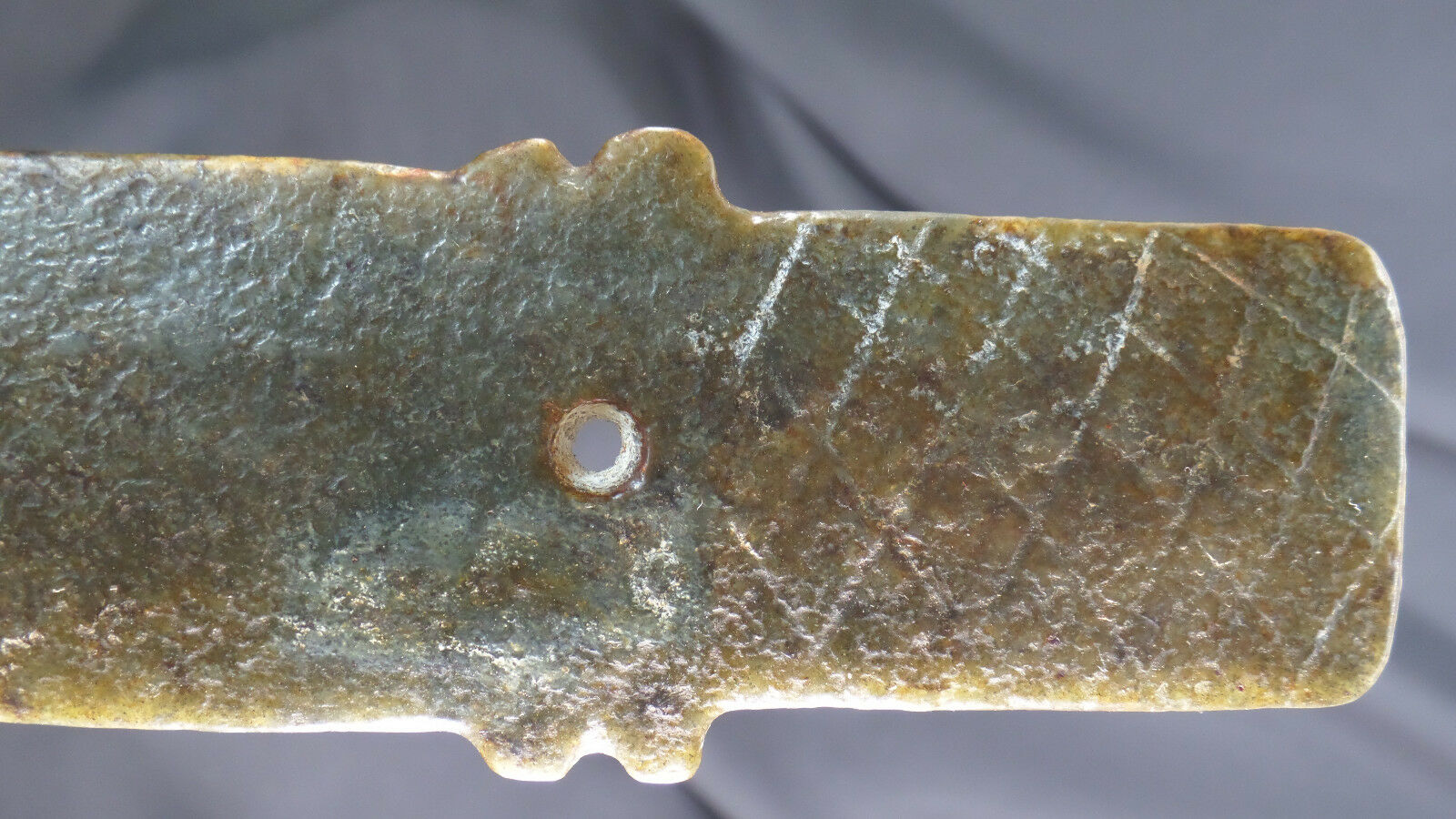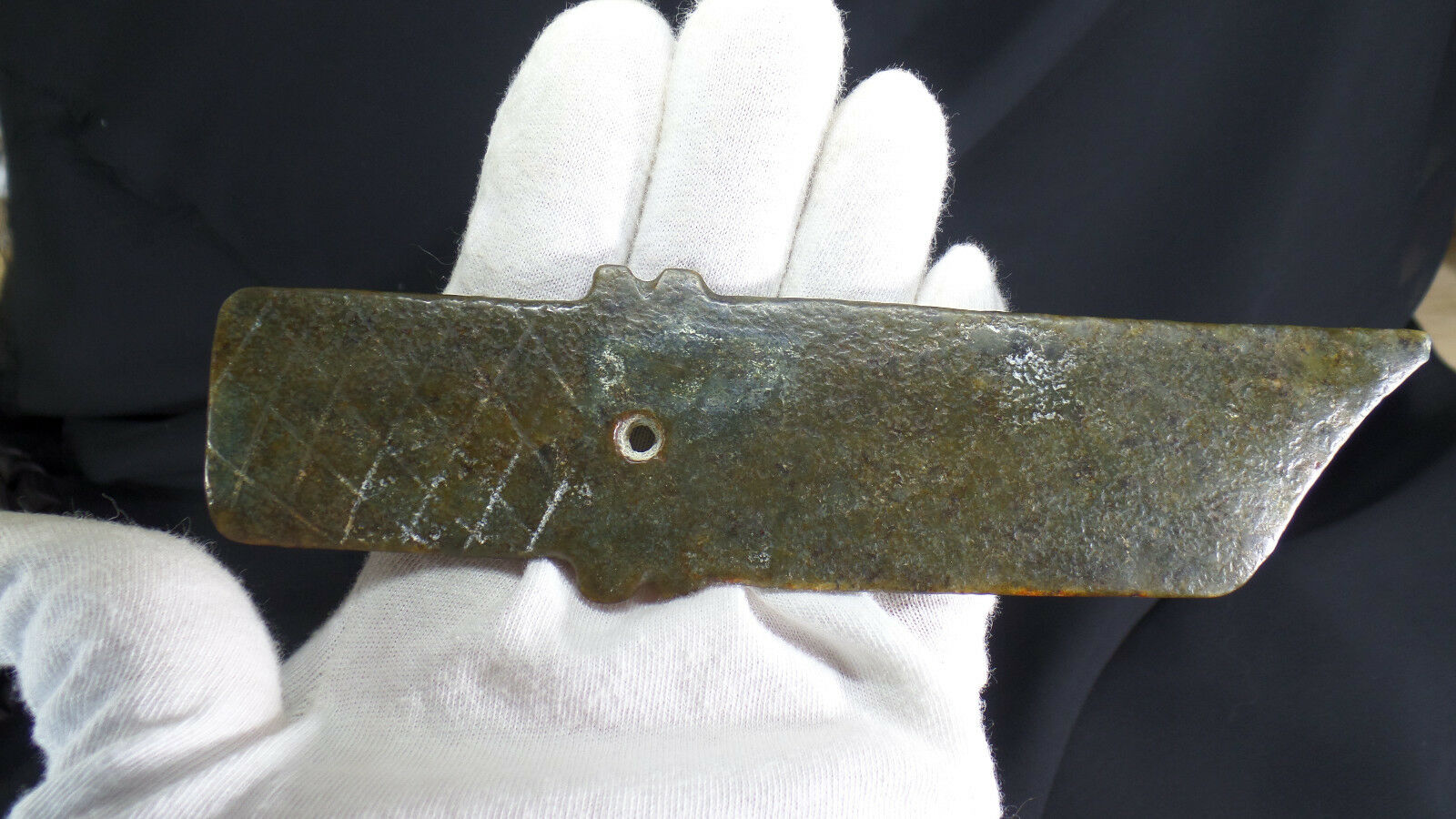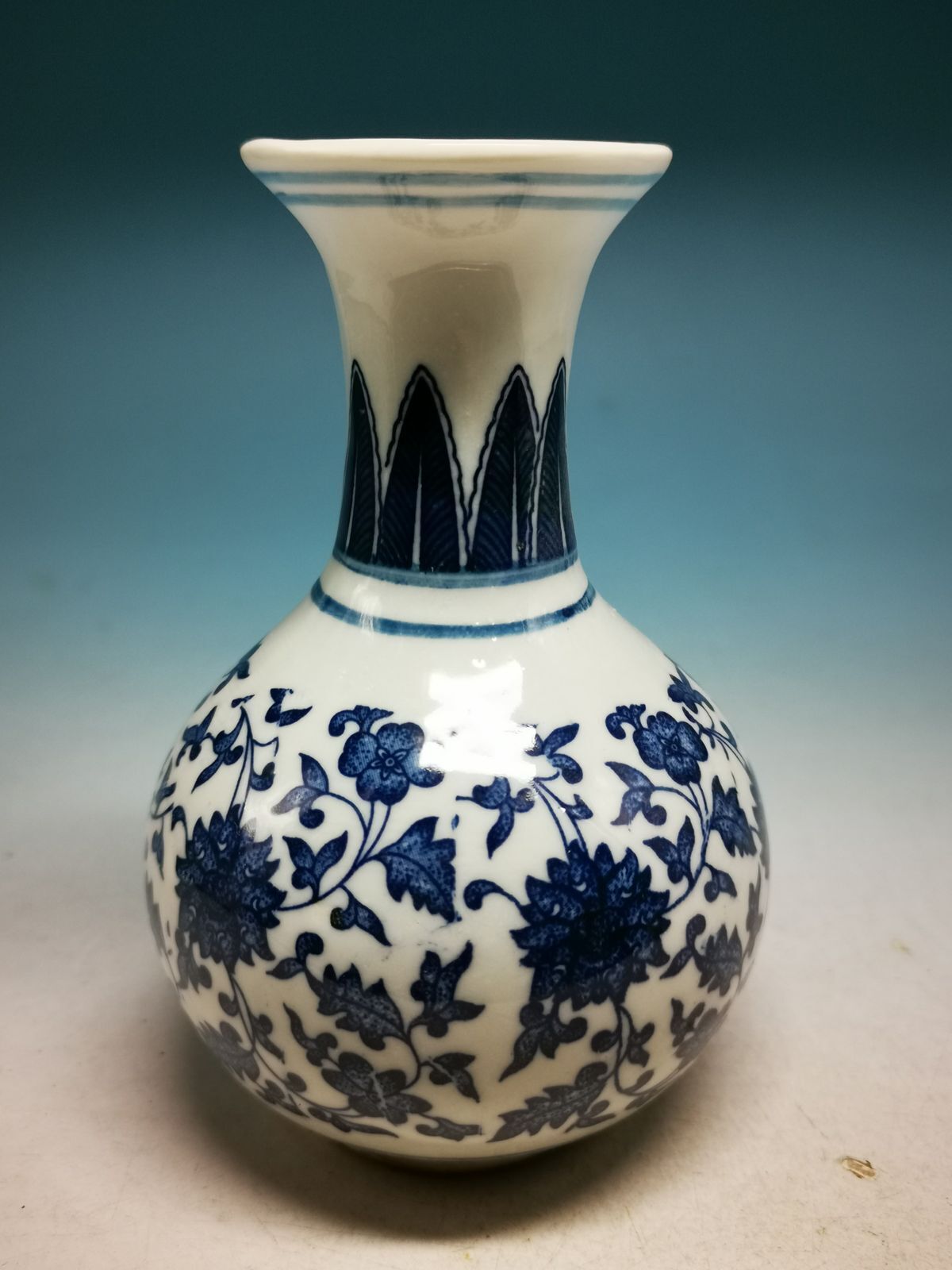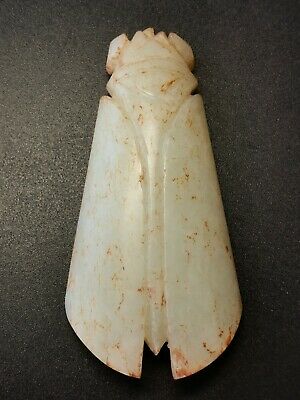-40%
Ancient Neolithic Chinese Ritual Jade Blade "Ge" Dragon Amulet--3000 BC-2250 BC
$ 608.25
- Description
- Size Guide
Description
ANCIENT CIVILIZATIONSAncient Art, Antiques, & Fine Collectables
Chinese Neolithic 6.25” Jade Ceremonial Amulet (
Ge
)
Ritual Trapezoid Jade Blade with Suspension Hole
Eternal Dragons Carved in Relief
c. Neolithic China
c. 3000 BC—2250 BC
est.
Liangzhu Culture (
3500 BC-2100 BC)
A gentleman always carried a jade pendant, as a symbol of class and to remind him the virtues of a gentleman, since those virtues were found in jade
.
—Confucius
NOTE: Please note that there are hundreds of modern reproduction axes for sale on eBay from China and the USA, but nearly all are modern fakes and some aren’t even jade. So please insure that you are bidding on the real thing if that is what you want before you bid. If you only want a reproduction piece for a few dollars that is just fine, just be sure you are getting the quality and authenticity you are paying for.
This small, Neolithic Chinese Jade Blade is made of pure, Nephrite Jade that is about 6.25" (16 mm) long x 1.46" (37 mm) wide x .25" (6.5 mm) thick and weighs about 2.6 oz. (73 grams).
Based upon the style and in comparison with known museum examples, this jade pendant dates to Neolithic China, which is approximately 3000 BC—2250 BC.
Chinese experts estimate that it was made during the Neolithic Culture of ancient China about 4,000 years ago!
I Guarantee it to be authentic and original!
It will appraise as such by any ancient Chinese expert collector or museum!
The edges of the once green Nephrite jade have turned a beautiful shade of burnt orange from being buried in the damp, iron-rich soil for millennia. It has cross-hatched patterns symbols carved into both sides of the trapezoidal blade’s handle where the blades handle would be found.
There appear to be two, dragons that have been carved in relief on the jade
ge
.
Both dragons appear to be heavily worn down, which suggests this pendant was worn for a long time before it was placed in a tomb for the journey to the afterlife.
Two dragons on either side of a ritual object was an ancient symbol of eternity.
One dragon is depicted with his mouth wide open, and likely symbolizes the dragon calling out to the Heavens that the man spirit wishes protection from the Evil Spirits as he journeys to the afterlife.
The small dragon that is depicted on the other side of the jade blade appears to be a pig Dragon that is facing left.
Look carefully and you should be able to see his snout, ears, and even his tiny legs.
It has been cleaned to reveal the stunning beauty of the jade and remains in good, museum-quality condition with no breaks, repairs, or restorations.
The jade does show heavy pitting and differential weathering that is consistent with being buried for over 4000 years.
DETAILS
Jade was highly prized by these early civilizations in China and it was thought to have positive energy to drive away evil spirits and bring good luck and fortune to all who wore a piece on their person--in life and in death. Jade was also believed to be a portal or messenger that could carry prayers to Heaven and send messages to those on Earth from departed ancestors and Gods in Heaven.
This small, ritual jade blade was made as an offering to the Gods and Ancestors in about 2500 BC. Offerings such as this stunning jade blade/axe (called a
Ge
in Chinese) were thought to allow the spirit of the departed warrior elite to enter Heaven and enjoy an eternal life. Jade was thought to frighten off Evil Spirits that would try to prevent the spirit from entering Heaven.
Here is a contemporary quote from the ancient Zhou King Ji Fa.
Note that the Zhou Dynasty King reportedly holds the "large axe in his left hand," which is how this axe is presented to the Gods. {see full translation below}
"At dawn on the Jiazi day, the {Zhou} King {Ji Fa} went out early to the plain of Mu on the outskirts of the Shang capital, and held an oath-taking. He held a large axe {yellow with gold} in his left hand, and a standard decorated with a white yak's tail in his right, and said, "
We have come a long way, people of the west!"
The King then said,
"Ah! Lords and ministers of my allied states, chief ministers, ministers of war, ministers of works, ya and lu officials, generals, commanders of a thousand men and commanders of a hundred men; people of Yong, Shu, Qiang, Mao, Hui, Lu, Peng, and Pu: {tribes}
Raise your ge, draw in your shields, lift your spears erect, and take this oath with me….."
{Prelude to the Battle at Muye, late 11th century BC.
Bamboo Annals
chronology 1027BC.}
In ancient China, the production of jade and bronze ceremonial pieces was strictly regulated by warlords and the emperor. Thus, the person who wore this ceremonial dragon pendant in the shape of a ge, would have had to have the approval of the royal house to have such a piece commissioned.
Dragon Symbolism in Ancient China
In ancient China, the symbolic jade
ge
with a two Dragons would have been placed in the tomb or temple of the departed by his family to protect him or her from Evil Spirits in this life and in the afterlife.
Evil Spirits were thought to lurk everywhere and jade pendants such as this one were often offered to the Gods as a sacrifice or as a prayer for rain or abundant crops.
In ancient China, the domesticated pig was a major source of food. Such a sacrifice would also show the spirits that he/she was a wealthy and honorable person. Jade was highly prized by these early civilizations in China and it was thought to have positive energy to drive away evil spirits and bring good luck and fortune to all who wore a piece on their person--in life and in death.
The fierce, Dragon Head on the other side suggests that it symbolized the power of its owner as well as a talisman to scare away Evil Spirits and to bring good luck in battle.
In China, the dragon is credited with having great powers that allowed it to make rain and control floods by striking the river with its mighty tail, for example. Dragons are also revered for their ability to transport humans to the celestial realms after death. They are symbols of the natural world, adaptability and transformation. When two dragons are placed together in opposite directions, they symbolize eternity, i.e., the famous Yin-Yang symbol.
The Chinese dragon symbolizes power and excellence, valiant and bold, heroism and perseverance, nobility and divinity. A dragon overcomes obstacles to achieve success. He is energetic, decisive, optimistic, intelligent and ambitious.
History
This
Ge
has a single hole drilled in the center of the trapezoidal axe that are classified as "double-bevel holes" by anthropologists (see photos).
This hole was drilled by hand from both sides of the blade with a slow-speed drill.
The hole is period correct and shows the growth of tiny micro-crystals of jade inside the bore holes that can only happen after a piece of carved jade has been buried for thousands of years.
These tiny crystals almost look like white powder and should never be cleaned off or removed.
The hole was made so a person could attach the precious jade
ge
around his neck or to his waist.
{REF: "
JADE
" by Roger Keverne, pg. 57. This is an excellent reference book that can be found on eBay.}
In ancient China, this jade axe would have been placed in the tomb or temple of the departed by his family to protect him or her from evil spirits on his journey to the afterlife and to allow him/her to enter Heaven.
It would also show the ancestors and spirits that he was a wealthy and honorable person and that he had Mandarins that could speak to the Heavens for him.
HISTORIC CHINESE JADE
The jade amulet blade called a "Ge" in Chinese, was one of the most important symbols in an elite burial tomb. In one famous burial tomb that contained 330 burial offerings, there were 44 stone and 12 jade axes. Jade axes were usually placed on the right side of the upper body in the tomb.{Ref: “
A Companion to Chinese Archaeology
” edited by Anne P. Underhill}
This wonderful Jade Amulet is shaped like an dagger and is decorated with a small suspension hole at the top that would allow a silk cord to be attached to the axe so it could be worn around the neck or more likely waist. The stone axe or blade was a common tool in ancient China, but these Jade blades were for ritual use only and can be found buried with their owners in ancient tombs. Chinese and Western experts believe these ritual axes (or "
yu
" in Chinese) denoted military authority when placed in a tomb.
Research on ritual jade daggers from China, reveal just how these lovely blades were made. The first step involved cutting the raw material into pieces with stone or bamboo saws and string saws soaked in a slurry of jade dust. Then the pieces were ground and abraded to a proper shape, as jade does not flake like flint. Next, a round hole was drilled in the top of the ge using a small bamboo tube. Finally, the jade was carefully polished and inspected before its delivery and presentation to its wealthy and powerful owner.
As noted jade expert Jessica Rawson explains, later Neolithic blades are thinner and more refined.
The Chinese word for jade is
“yu”
and this jade ritual axe is made from ancient nephrite jade that has been beautifully crafted in a fantastic cultural masterpiece. Interestingly, jade is the one really hard material available in Neolithic China during pre-metal times, but which was not used for tools that could have benefited most from its use. It easily dates to 4,000 or 5,000 years old.
It is made of pure Nephrite jade and has a wonderful, authentic patina from the iron and minerals in the soil that it was in contact with for 4,000 years! It also is pitted from differential weathering and has white calcification from the salts that have leached into the jade--all clear indicators of an authentic and original piece.
This is completely natural and is perhaps the best clue to look for in determining the age of jade.
I have carefully examined and authenticated this ritual Jade Axe as 100% authentic and original!
It will appraise as such by any knowledgeable Chinese jade expert or museum.
I GUARANTEE it to be 100% authentic or your money back!
NOTE: For reference on how to purchase authentic archaic jade, may I refer you to an excellent book published in 2009 by Stephen Payne called "How to Purchase Archaic Jade." He shows in great detail how the experts determine the age and date of ancient Chinese Jade. This book is well worth the price if you are just starting your collection or if you are a seasoned "expert."
Please look carefully at the photos, since they are part of the description and show how the artist has made this magical amulet come to life!
It would make a
wonderful
addition to your collection or a Super gift!
And please ask any questions before you buy.
I
GUARANTEE
this pendant to be original and authentic or your money back! Thanks!
Note:
Please ask any questions you may have before you bid! Thanks for Looking!
Per e-Bay's rules, Paypal only please!
FREE SHIPPING & Insurance for all the 50 United States.
Note: Washington State residents must also pay the Washington State Sales Tax. Thank You.
